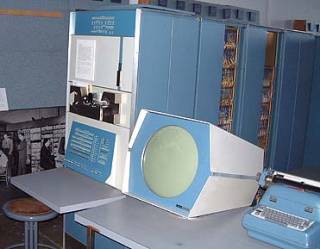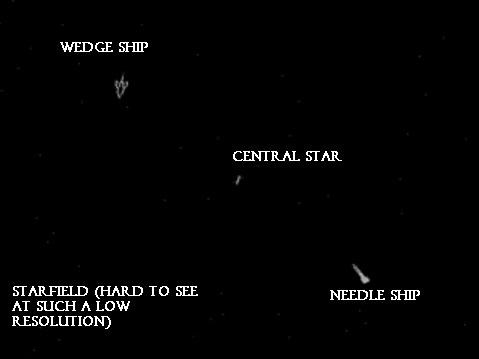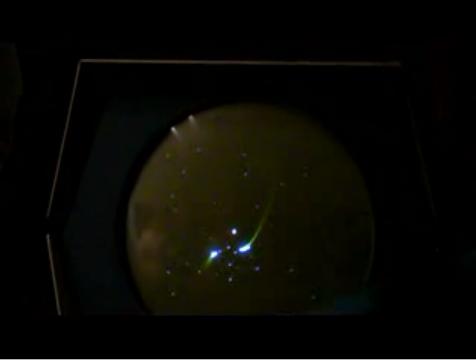Whew, done. At least for now. I'm going to re-read the section in Levy's book and add some other facts as recorded by J. Martin Graetz.
I am more than a bit proud of this article (let me know about any errors, omissions, whatever):
The History and Impact of Spacewar! (1962)
Spacewar! was one of the first graphical video games in existence. There were games before Spacewar!; two frequently cited examples are OXO, a Tic-Tac-Toe game developed by A.S. Douglas in 1952, and Tennis for Two (perhaps an inspiration for the famous Pong) developed by William Higinbotham as an independent, analog device (instead of a piece of software developed for an existing system). The impact, though, of Spacewar! and its resultant dissemination among the small groups of computer users and programmers at the time arguably helped pave the way for the popularity of video games that was to explode in the coming decades.
Background

Using sine/cosine functions acquired by Alan Kotok from DEC, Steve Russell set about coding what would become Spacewar! in February of 1962. The reason, though, that the authorship of the game itself can not be put on one man was that the development of the game did not resemble the compartmentalized structuring that many programming firms use today. The basic game which Steve Russell wrote was later added to by other programmers, many working at what Russell had dubbed The Hingham Institute Space Warfare Study Group, a fancy way of saying Russell's house.
Game

One notable addition was Peter Samson's star field (dubbed Expensive Planetarium, the term expensive being a joke referring to how much the machine itself had cost). This starfield was an accurate representation of the night's sky, in contrast to the random star field coded by Russell. Samson's star field slowly rotated as the game progressed, giving players a full view of the actual position of stars over time. This did not add to game play as such, but it did show off the processing power of this machine to contemporaries.
Other options were added and features changed. These included toggle switches that altered gameplay: the central star's gravity could be switched on and off, the existence of angular momentum could be removed, the star field could be switched off, and a "winds of space" feature could be added which pushed spaceships in one direction, forcing players to use more thrust to go in certain directions and causing drift.
A full list of the contributors to the development of the initial game of Spacewar! (as far as this author could discern) will be included at the end of this article.
Impact
As there was no video game market, and the machine that used Spacewar! was prohibitively expensive to all but the most wealthy institutions, it was decided that the game, as popular as it was with everyone who played it, would be distributed freely, and the source code was given to anyone who requested it. New PDP-1 machines were shipped with the game in their memory, both as a demonstration of its visual functions and its processing power. The game was also a valuable tool to debug the machine out of the box in case of irregularities.
Many of those who are now thought of gaming gurus, who lived through this early era in computing, had their start with Spacewar! It can be said that the game's influence helped energize the next generation of software designers, who would eventually create the first home video game consoles and arcade machines.
Spacewar! was remade in both arcade and home form. Features like gravity would later influence many games, and gravity, angular momentum, ammunition and fuel limits, and Samson's desire for a realistic star chart would hint at the coming desires for realistic physics and verisimilitude. Games that would borrow heavily from the formula of Spacewar and its clones were Asteroids, now one of the famous games from the early era of popular video games, and Star Control, which even had a gravity well at the center of the playfield while two ships with limited resources duelled for supremacy.
While Spacewar was by no means capable of entering every home on the cumbersome, expensive PDP, it helped show the appeal for such entertainment, and can be argued to have helped bring about the current age of video game entertainment.
End Notes

Notice the streak effect behind the two ships, which helps opponents judge velocity.
Credited contributors to the game:
Conceived by
Steve "Slug" Russell
Martin "Shag" Graetz
Wayne Wiitanen
Initial Coding by
Steve Russell
Contributing features created by
Dan Edwards
Peter Samson
Martin Graetz
Alan Kotok
Steve Piner
Robert A. Saunders
Sources for this article as of November 22, 2008:
http://www.stevenlevy.com/index.php/other-books/hackers
http://en.wikipedia.org/wiki/Spacewar!
http://www.computerhistory.org/pdp-1/index.php?f=theme&s=4&ss=3
http://www.cnn.com/books/beginnings/9801/31/joystick.nation/index.html
http://www.youtube.com/watch?v=Rmvb4Hktv7U
http://www.transbay.net/~enf/lore/spacewar/spacewar.html
http://www.cs.uakron.edu/~margush/465/01_intro.html
http://www.youtube.com/watch?v=g56ptrkY3E0
Log in to comment